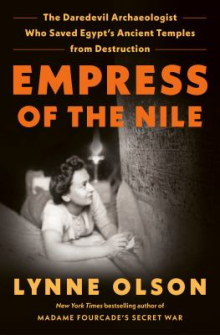
Christiane Desroches-Noblecourt was born in Paris, France, November 17, 1913, and her lifelong passion for Egypt began as a toddler when her grandfather took her to see the Luxor Obelisk in the Place de la Concorde. He told her about its history and connection with France. As a child the history did not interest her as much as the hieroglyphs. “Those images spoke to me.” A few years later, she became fascinated with the Egyptian antiquities at the Louvre. Eventually she became the world’s leading expert on ancient Egypt; a trained, experienced archaeologist; and also, during World War II she was a spy for the Allies. “A willful real-life female version of Indiana Jones, she told an interviewer many years after the war, ‘You don’t get anywhere without a fight, you know. I never looked for the fight. If I became a brawler, it was out of necessity.’” Over her lifetime, there were many fights that she took on, all for good causes.
In 1833 the Luxor Obelisk was a gift to the king of France as an appreciation for France’s history with Egypt, going back to 1798. At that time Napoleon Bonaparte launched a military excursion to annex Egypt so that France would be a dominant force in the Mediterranean. Along with the military contingents the expedition was comprised of, “Experts in various fields, they included artists, engineers, linguists, cartographers, historians, mineralogists, botanists and other scholars–all there to study Egypt and its people, both past and present.” The military campaign was a flop, with Admiral Horatio Nelson, in command of the British fleet, defeating the French navy in the Battle of the Nile. The scholarly part was a major success and introduced to France and other western countries the, “vibrant civilization that predated both the Romans and Greeks." The competitive rivalry between France and England for territory and military advantage would increase and extend over the decades and involve archaeological research in Egypt. In 1922 British archaeologist Howard Carter unearthed the tomb of King Tutankhamun which provided a vast array of artifacts and created a global interest in ancient Egypt, and further ignited nine-year-old Christiane's interest.
After attending the Lycée Molière, a high school for girls, it was a matter of choosing a subject to study in college. Her obsession with ancient Egypt was not considered. “At the time, we never considered a career for me as an Egyptologist,” she said. “It was considered a fad, a madness, not a profession.” It would be possible for her to study art history (16th century French drawing) at the Sorbonne and at the École du Louvre. The subject bored her stiff. However at the Louvre there was a class in Egyptian archaeology and another one deciphering hieroglyphs. And this formed the jumping off point for her life as an archaeologist, with a singular focus on ancient Egypt, that continuously was interwoven with adventure, misogyny; racism; sterotyping of indigenous peoples; continuous internecine fights, squabbles and competition among archaeologists and countries. Her major crowning achievement would develop despite those obstacles and many others.
During his time as President of Egypt, Gamel Abdel Nasser considered the construction of the Aswan Dam to be part of the modernization of Egypt. Writer Lynne Olson provides a detailed history and analyses of what this meant in terms of international relations and Egyptian history. The part that concerned Christiane Desroches-Noblecourt was the damming of parts of the Nile River that would flood and cover major ancient historical sites, e.g., approximately twenty-two monuments and major architectural complexes. This story and battle would involve the successful assistance of two unlikely women (Jacqueline Kennedy and Germaine Ford de Maria) whose knowledge, interests and abilities to leverage power were relatively unknown. The sections about Jacqueline Kennedy are revelatory. Her appearance as an ethereal fashionista belied a woman of great knowledge about many subjects, especially domestic and international politics, who possessed an enormous ability and determination to persuade those in power (including her husband, President Kennedy) about what was the right course of action to take. In her behind-the-scenes, and successful, crusade to save the buildings surrounding Lafayette Square she presciently said, “Perhaps saving old buildings and having the new ones be right isn’t the most important thing in the world–-if you are waiting for the bomb–-but I think we are always going to be waiting for the bomb and it won’t ever come, and saving the old–-and making the new beautiful–-is terribly important.” Jacqueline Kennedy played a major role in securing U.S. funds to rescue historical monuments before they were engulfed in water from the Aswan Dam. The biographical information about Germaine Ford de Maria is the stuff of romance novels--most incredible! She too was a force to be reckoned with and was instrumental in funding Christiane Desroches-Noblecourt's exploration and restoration of the Valley of the Queens.
Archaeological excavations are about unearthing and deciphering historical artifacts, sometimes documents that are inscribed on tablets, ceramics, rocks or paper, and shining a light on past history. The contributions made by Christiane Desroches-Noblecourt achieved that and fired up an interest in others to do the same. For many of us our knowledge about ancient Egypt is insufficient and has been colored by motion pictures. In presenting the biography and contributions of one audacious woman, Lynne Olson notes the following: “The oldest nation-state in history, Egypt had been welded into a single country more than 3,200 years before the birth of Christ … The Egyptians’ invention of the concept of a unified nation, whose population shared a common identity, was remarkable not only for its impact on the world but also for its longevity.” According to Cambridge Egyptologist Toby Wilkinson, “The pharaonic state as originally conceived lasted for three millennia. By comparison, Rome barely managed one millennium, while western culture has yet to survive two.”